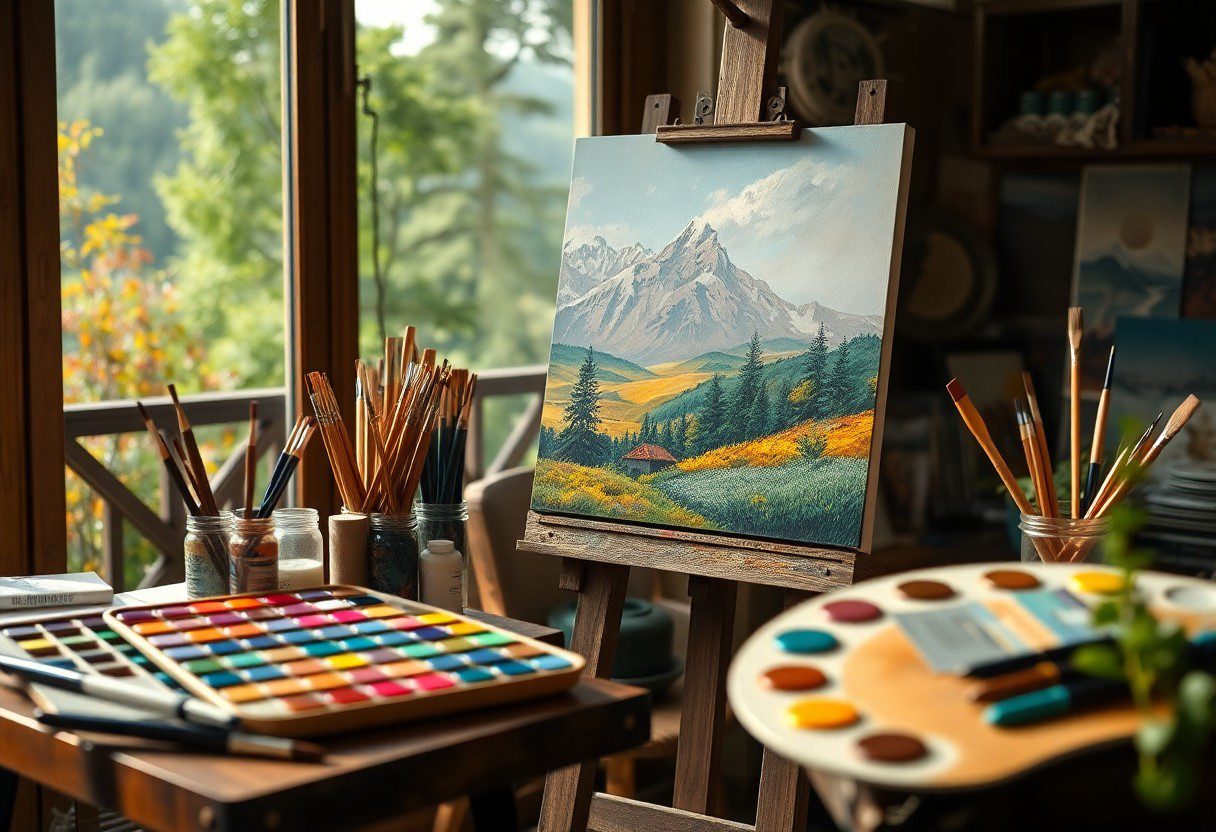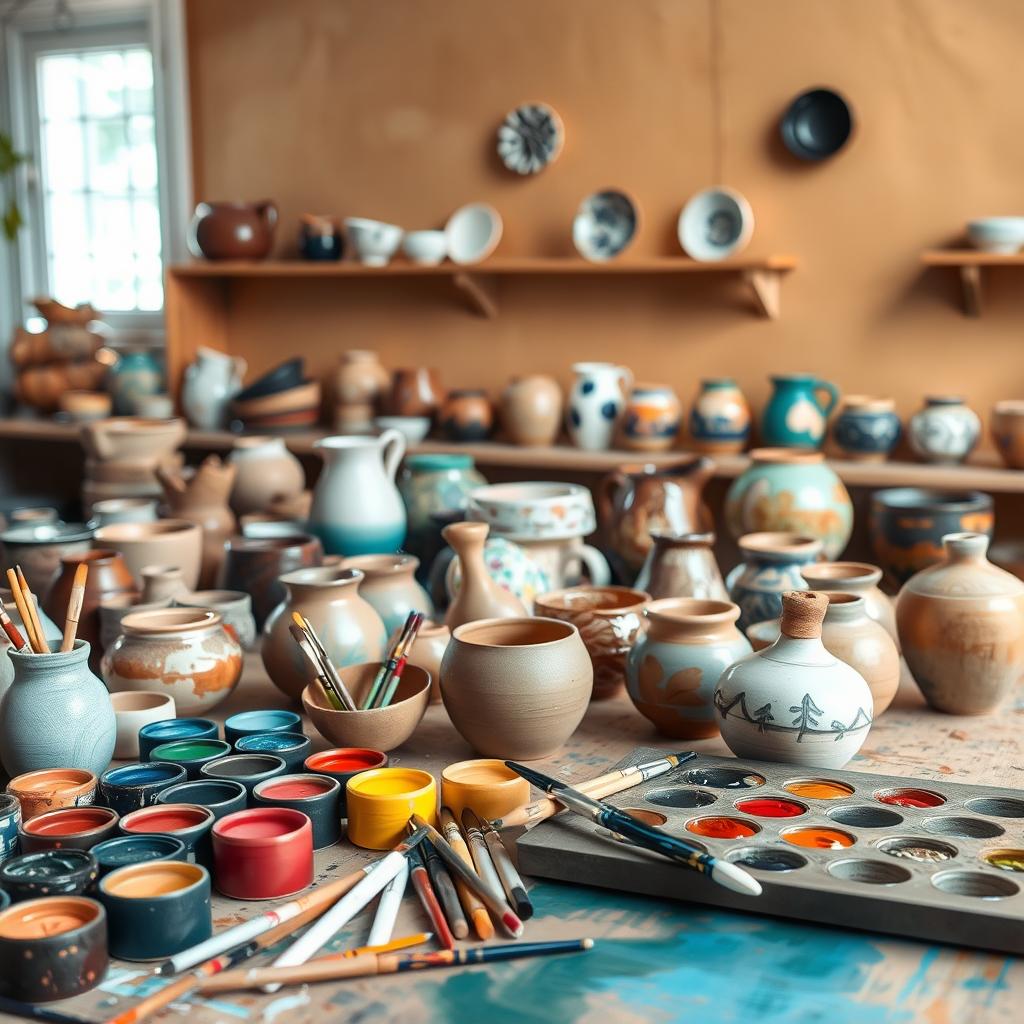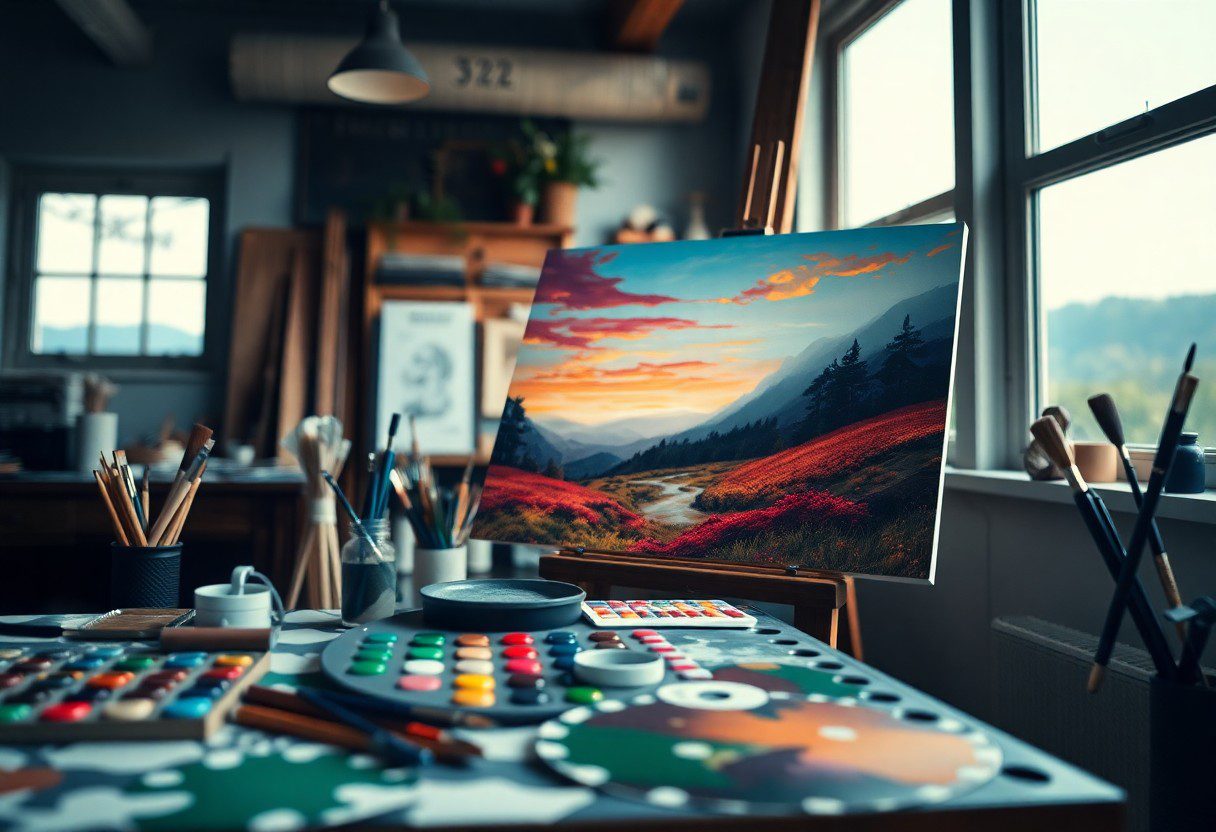Most artists understand that the quality of your materials can significantly impact the outcome of your landscape paintings. By choosing high-grade paints, brushes, and canvases, you can elevate your work and achieve rich, vibrant colors and stunning textures. In this post, you’ll discover how selecting the right supplies not only enhances your artistic expression but also improves the longevity and presentation of your landscapes. Get ready to explore the important tools and resources that will help you create breathtaking scenes that captivate your audience.
Understanding Quality Art Supplies
To create stunning landscape paintings, you need to prioritize the quality of your art supplies. High-quality materials not only enhance your artwork but also improve your overall painting experience. Investing in superior paints, brushes, and canvases allows you to achieve richer colors, smoother textures, and greater precision in your work. As you explore your artistic potential, understanding what makes these supplies stand out is crucial for your growth and success as an artist.
Importance of Paints
Against popular belief, the type of paints you choose significantly impacts the final result of your artwork. High-quality paints offer better pigmentation, which translates into vibrant hues and shades, allowing you to bring the scenery to life. They also have a superior consistency, resulting in smoother application and blending, ultimately ensuring your paintings achieve the depth and richness you desire.
Choosing the Right Brushes
One key factor in enhancing your landscape paintings is selecting the right brushes. The brush type affects how you manipulate the paint and create textures, shapes, and details within your artwork.
Due to the variety of brushes available—each designed for specific tasks—it’s crucial to familiarize yourself with them. Flat brushes are perfect for broad strokes and washes, while round brushes excel in detail work and fine lines. Filbert brushes combine the features of both, providing versatility for blending. Investing in a range of brush sizes and shapes helps you achieve various effects, enabling your creativity to flow seamlessly across the canvas.
Selecting the Perfect Canvas
The right canvas can significantly enhance your landscape paintings, providing a solid foundation for your creative expression. Choosing a canvas that suits your style and technique is imperative for achieving your desired artistic effects. Ensure you consider the texture, weight, and material of the canvas, as these elements will influence the final result of your artwork.
Types of Canvas
Between different types of canvas, you will find options that best fit your painting style:
| Cotton Canvas | Affordable and versatile, suitable for various painting techniques. |
| Linen Canvas | More expensive, with a rich texture ideal for high-quality work. |
| Primed vs. Unprimed | Primed canvases save time, while unprimed allows for more customization. |
| Stretched Canvas | Ready to use, providing a convenient option for immediate painting. |
| Canvas Boards | Sturdy and portable, great for traveling artists. |
Assume that the quality of your canvas directly impacts your artwork’s longevity and presentation.
Preparing Your Surface
The preparation of your canvas surface is an imperative step in creating successful landscape paintings. Properly priming and stretching your canvas can enhance paint adherence and vibrancy, leading to optimal results.
Types of preparatory treatments you can use include gesso, which offers a smooth finish, as well as various textured solutions for a more dynamic surface. You may also choose to apply additional layers of gesso to achieve the desired texture or tone before you start painting. Always ensure your surface is clean and free of debris for the best result. A well-prepared canvas ensures that your colors remain vibrant and true to life, showcasing the beauty of your landscape artwork.
Enhancing Colors with Mediums and Varnishes
Now that you understand the importance of high-quality supplies, enhancing the colors in your landscape paintings can greatly improve their vibrancy and depth. By incorporating mediums and varnishes, you’ll have the tools to manipulate texture and finish, elevating your artwork to new heights.
Different Types of Mediums
Above, you’ll find that various mediums serve unique purposes in your painting process. Each type can modify the consistency, drying time, and sheen of your paint, allowing you to achieve different effects.
| Medium Type | Purpose |
| Linseed Oil | Enhances flow and gloss |
| Turpentine | Thins paint for washes |
| Acrylic Binder | Improves adhesion |
| Watercolor Mediums | Manipulate transparency |
After exploring different types of mediums, you’ll find that each one offers unique benefits tailored to your artistic needs.
The Role of Varnishes
Between mediums and varnishes, the latter plays an necessary role in protecting your artwork. Varnishes not only enhance the visual appeal by adding a gloss or satin finish, but they also shield your painting from dust, UV rays, and environmental damage.
For instance, a gloss varnish will intensify the colors and give your painting a wet look, making it particularly suitable for vibrant landscapes. In contrast, a matte varnish minimizes glare, providing an elegant finish while preserving the original colors. Knowing how to choose and apply varnishes can significantly extend the life and beauty of your artwork, ensuring your landscapes continue to captivate viewers for years to come.
Tools for Texture and Technique
Not all tools are created equal when it comes to achieving texture in your landscape paintings. Investing in high-quality brushes, palette knives, and unconventional tools can elevate your artwork and allow you to explore various effects. Utilize a range of sizes and shapes to create depth and interest; the right tool can dramatically change your approach to painting landscapes.
Palette Knives and Other Tools
Against traditional brushwork, palette knives offer a fresh approach to texture in your landscapes. They can create sharp lines, add dimension, or produce rustic, impasto effects that are impossible to achieve with a standard brush. Additionally, consider experimenting with sponges, rags, or even your fingertips to find unique ways to apply paint and manipulate the surface.
Implementing Textural Techniques
By incorporating textural techniques into your work, you can capture the essence of natural landscapes more vividly. Techniques such as layering, scumbling, and wet-on-wet painting allow you to mimic the complex surfaces found in nature. Mixing mediums or adding materials to your paint can enhance these effects, providing a tactile quality that engages viewers.
In addition to layering and wet-on-wet techniques, don’t shy away from exploring other textural elements like dry brushing or using sand and gel mediums mixed with paint. These methods will help create surfaces that reflect the nuances of natural textures, whether it’s rough tree bark or the smooth glisten of calm water. Regular experimentation with these techniques will guide you toward developing your personal style, enhancing your landscape work significantly.
Organizing Your Workspace for Efficiency
Unlike a cluttered environment that can stifle creativity, an organized workspace allows you to work more efficiently and effectively. By arranging your supplies and tools in a systematic way, you reduce the time spent searching for what you need. This organization not only enhances your workflow but also creates a more enjoyable and stress-free painting experience. Prioritize an arrangement that suits your habits, allowing for both productivity and inspiration as you paint your landscapes.
Setting Up Your Studio
The first step in setting up your studio is to designate a space that inspires you. Consider natural light sources, ventilation, and a layout that aligns with how you paint. Keep your easel within easy reach and ensure that your most-used supplies are nearby to maintain a fluid working process. Personalize the environment to motivate your creativity, and regularly reassess the setup to suit your evolving needs as an artist.
Keeping Your Supplies Accessible
For a streamlined painting experience, it’s important to keep your supplies accessible, eliminating the need to interrupt your flow. Organize paints, brushes, and tools in a way that makes sense to you, perhaps by color, type, or frequency of use. Taking a moment to design a storage system that works for you will save time and enhance your efficiency during painting sessions.
Workspace organization plays a vital role in your creative process. Consider utilizing clear containers, toolboxes, or shelves to keep everything visible and within reach. Label your materials when possible so each item has a designated space, making it easy for you to find the right color or brush in moments of inspiration. By creating a functional and accessible environment, you empower yourself to focus solely on your artistry, allowing your landscape paintings to thrive.
Maintenance of Art Supplies
Once again, maintaining your art supplies is important for achieving the best results in your landscape paintings. Regularly checking the condition of your materials will ensure that they perform optimally and that you can work efficiently. By establishing a routine for cleaning and storing your supplies, you not only prolong their life but also enhance the quality of your artwork. A little care goes a long way in preserving your tools and ensuring your creative journey remains enjoyable.
Storing Your Supplies Properly
Around your studio, establish designated areas for each type of art supply. This helps to organize your materials and prevent damage. Use airtight containers for paints and solvents to prevent them from drying out, and keep tools away from direct sunlight and extreme temperatures. With proper storage, you’ll maintain the integrity of your supplies, making them ready for your next masterpiece.
Caring for Brushes and Other Tools
Beside proper storage, taking care of your brushes and tools is vital. Clean your brushes thoroughly after each use to prevent paint from hardening in the bristles, which can affect performance. Use gentle soap and warm water, rinsing until the water runs clear. For palette knives and other tools, wipe off excess paint immediately after use, keeping them in pristine condition. This attention to detail will improve your painting experience and outcomes.
Properly maintaining your brushes and tools also includes reshaping brush bristles after cleaning and storing them upright or flat to avoid deformation. Use a brush holder or a dedicated container to protect your brushes from damage. Inspect your tools regularly for wear and tear; replacing them as necessary can prevent frustration during your painting sessions. Consistent care will provide you with reliable and effective tools, allowing you to focus on your creativity rather than equipment issues.
Summing up
The quality of your supplies significantly impacts the outcome of your landscape paintings. By investing in high-grade paints, brushes, and canvases, you elevate not only the vibrancy and texture of your work but also enhance your overall painting experience. Quality tools allow you to execute your artistic vision with precision, giving you the confidence to experiment and express yourself fully. As you refine your skills, the right materials will empower you to create captivating landscapes that truly reflect your unique perspective.
FAQ
Q: What types of paint should I use for landscape painting?
A: For landscape painting, oil paints and acrylics are popular choices. Oil paints offer rich colors and a smooth blending experience, making them suitable for detailed work. Acrylics, on the other hand, dry quickly and are versatile, allowing for a variety of techniques. Watercolors can also be used for soft, transparent effects, particularly in plein air painting. The choice of paint ultimately depends on your personal preference and the effects you wish to achieve.
Q: Which brands of brushes are recommended for landscape painting?
A: When deciding on brushes for landscape painting, you should look for high-quality brands that offer a variety of shapes and sizes. Popular brands include Winsor & Newton, Da Vinci, and Escoda. A mix of flat, round, and filbert brushes can help you achieve different textures and details in your landscapes. Additionally, consider using palette knives for creating unique effects and texture in your work.
Q: What surfaces are best for painting landscapes?
A: The choice of surface can significantly affect your painting experience. Canvas boards, stretched canvases, and watercolor paper are commonly used surfaces for landscape paintings. Primed canvas provides a smooth surface for oils and acrylics, while watercolor paper is ideal for water-based mediums. For a more textured effect, you might try wood panels or canvas panels. Choose a surface that suits your preferred medium and technique.
Q: How can I enhance my landscape paintings with quality supplies?
A: Enhancing your landscape paintings involves using quality supplies that cater to your artistic style. Start by investing in professional-grade paints that offer better pigmentation and durability. Choose brushes that suit your technique, ensuring you have options for both fine detail and larger strokes. Additionally, consider the lighting and environment when painting, as they can greatly influence the final result. Utilizing good quality canvases or papers will also improve the overall look of your finished piece.
Q: Is it worth investing in more expensive materials for landscape painting?
A: Yes, investing in higher-quality materials can lead to better results in your landscape paintings. Premium paints often provide richer colors, greater opacity, and improved blending capabilities. Quality brushes retain their shape longer and facilitate finer techniques. Although the initial cost may be higher, the benefits in terms of ease of use, durability, and improved artwork can outweigh the expense over time.





